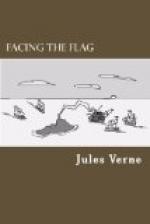The island well merits its name of Back Cup. It is indeed a gigantic cup turned upside down, not only to outward appearance, but inwardly, too, though people are ignorant of the fact.
I have already remarked that the Beehive is situated to the north of the lagoon, that is to say to the left on entering by the tunnel. On the opposite side are the storerooms filled with provisions of all kinds, bales of merchandise, barrels of wine, beer, and spirits and various packets bearing different marks and labels that show that they came from all parts of the world. One would think that the cargoes of a score of ships had been landed here.
A little farther on is a large wooden shed the nature of which is easily distinguishable. From a pole above it a network of thick copper wires extends which conducts the current to the powerful electric lights suspended from the roof or dome, and to the incandescent lamps in each of the cells of the hive. A large number of lamps are also installed among the stone pillars and light up the avenues to their extremities.
“Shall I be permitted to roam about wherever I please?” I ask myself. I hope so. I cannot for the life of me see why the Count d’Artigas should prohibit me from doing so, for I cannot get farther than the surrounding walls of his mysterious domain. I question whether there is any other issue than the tunnel, and how on earth could I get through that?
Besides, admitting that I am able to get through it, I cannot get off the island. My disappearance would be soon noticed, and the tug would take out a dozen men who would explore every nook and cranny. I should inevitably be recaptured, brought back to the Beehive, and deprived of my liberty for good.
I must therefore give up all idea of making my escape, unless I can see that it has some chance of being successful, and if ever an opportunity does present itself I shall not be slow to take advantage of it.
On strolling round by the rows of cells I am able to observe a few of these companions of the Count d’Artigas who are content to pass their monotonous existence in the depths of Back Cup. As I said before, calculating from the number of cells in the Beehive, there must be between eighty and a hundred of them.
They pay no attention whatever to me as I pass, and on examining them closely it seems to me that they must have been recruited from every country. I do not distinguish any community of origin among them, not even a similarity by which they might be classed as North Americans, Europeans or Asiatics. The color of their skin shades from white to yellow and black—the black peculiar to Australia rather than to Africa. To sum up, they appear for the most part to pertain to the Malay races. I may add that the Count d’Artigas certainly belongs to that particular race which peoples the Dutch isles in the West Pacific, while Engineer Serko must be Levantine and Captain Spade of Italian origin.




